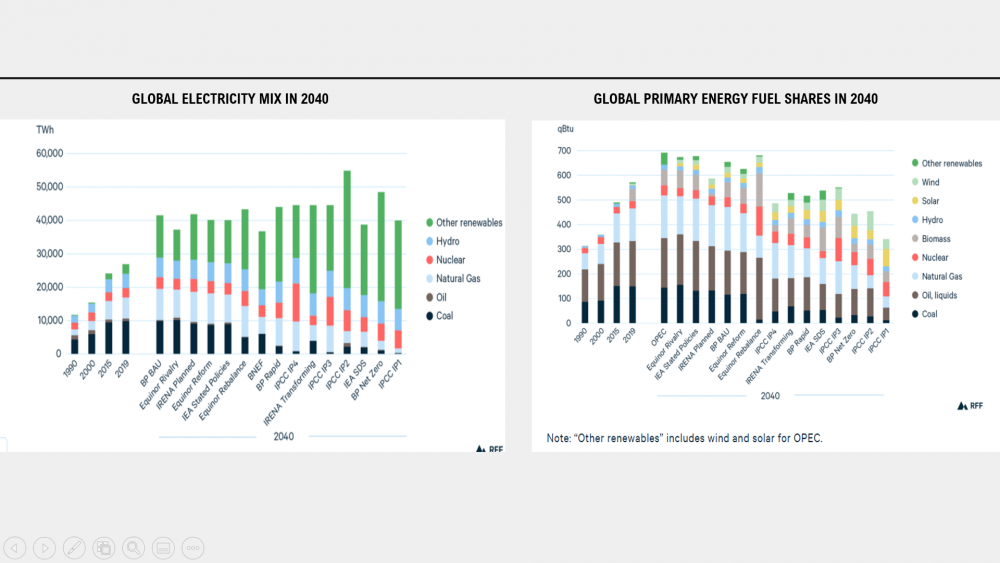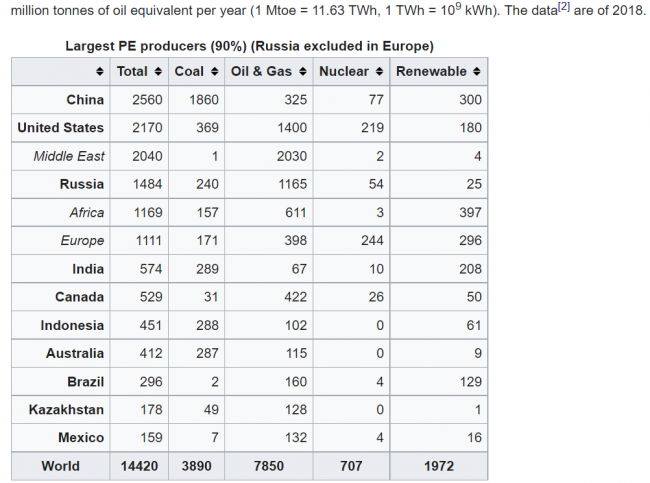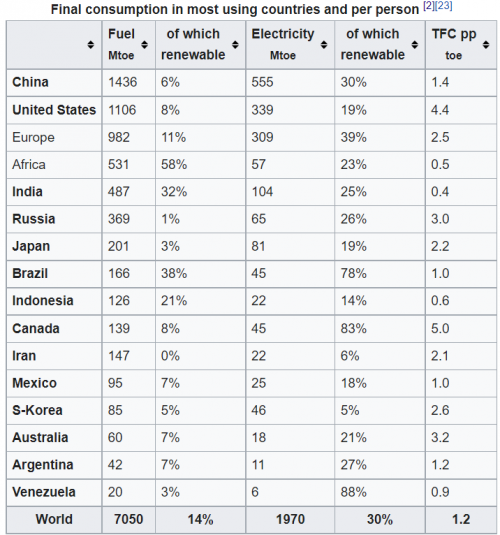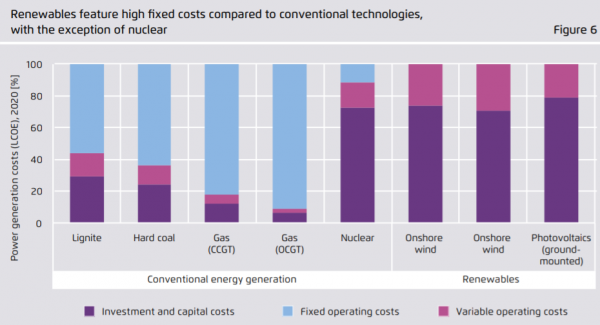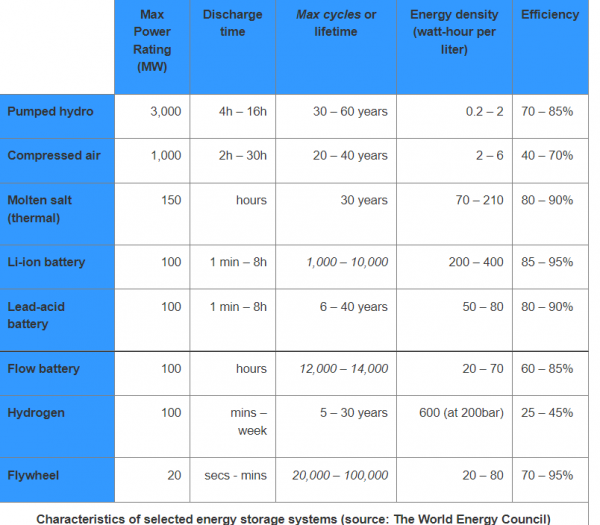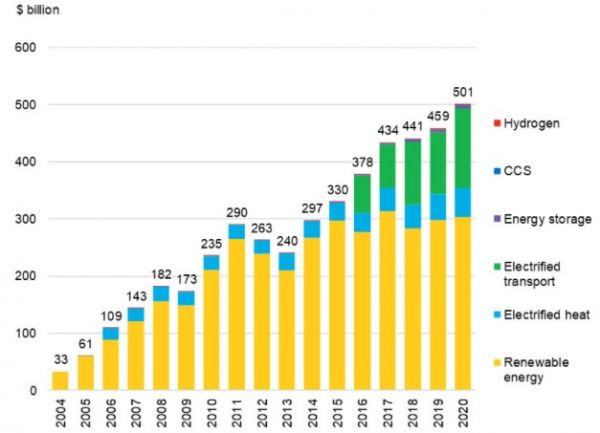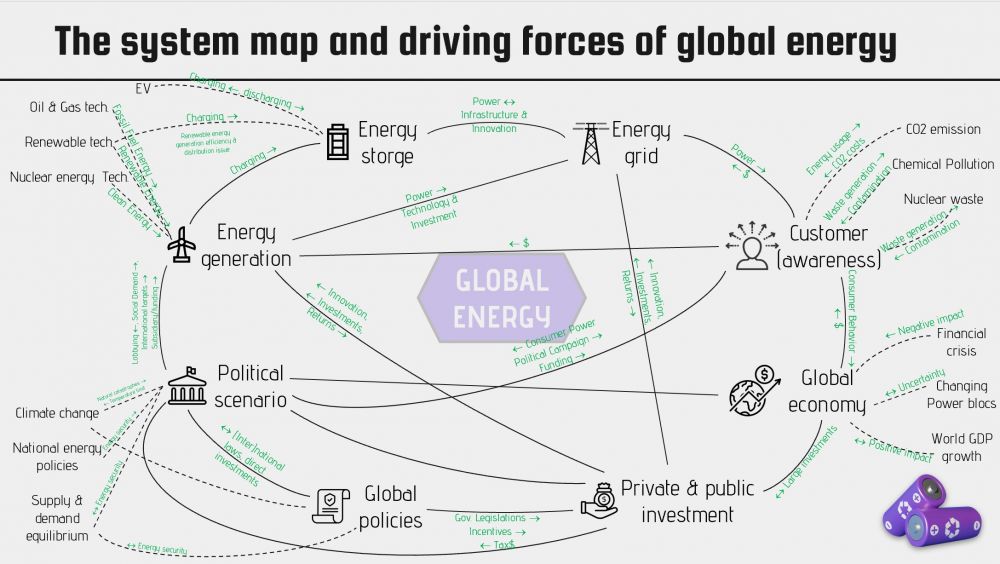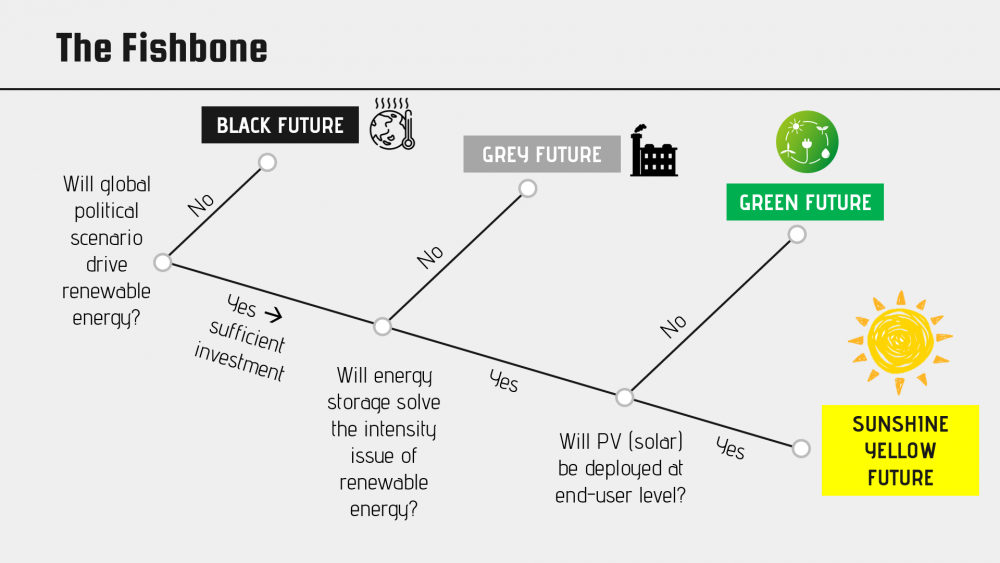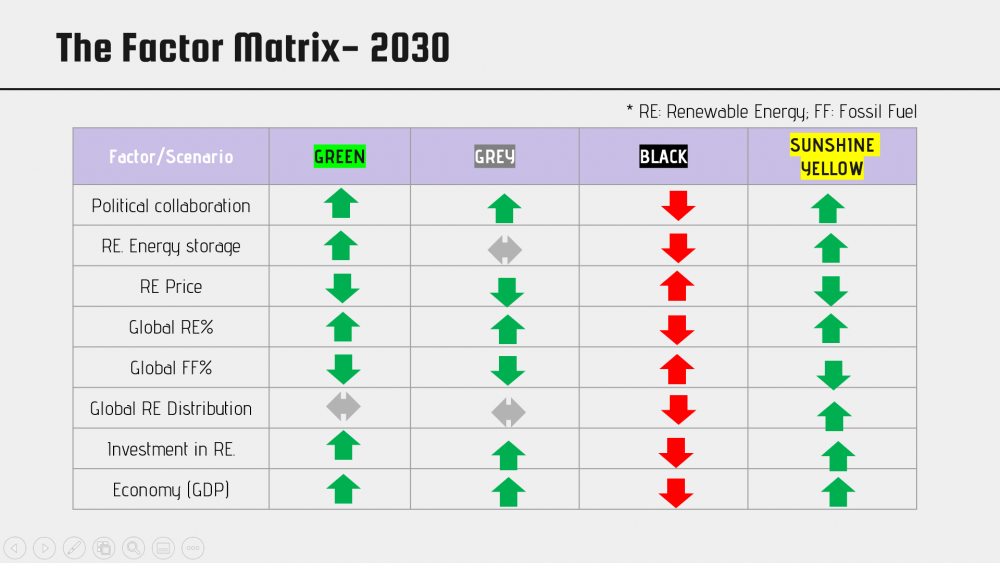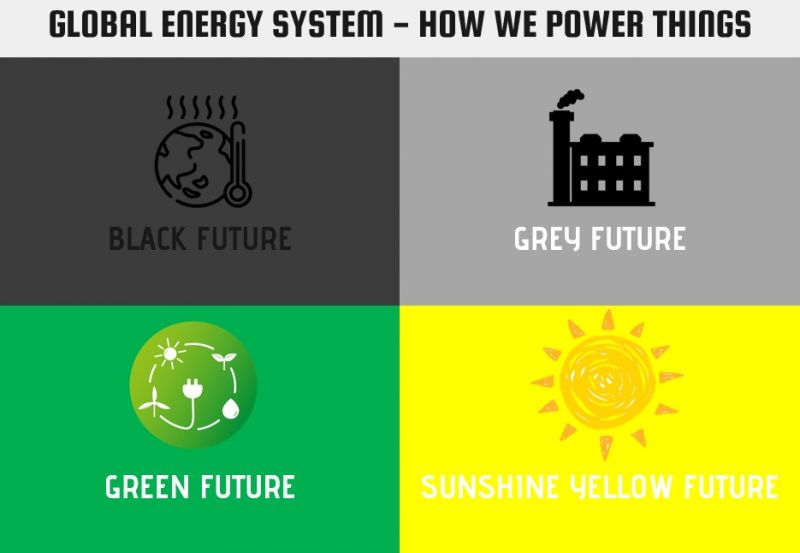Difference between revisions of "Global Energy System- How we power things"
| Line 222: | Line 222: | ||
2030<br> | 2030<br> | ||
The global economy heats up with a total GDP of $114 trillion. Global renewable energy investment reaches $694 billion (doubled from $365 billion in 2020), the energy storage capacity has only doubled (to 34 GW), marginally compared the renewable energy installations. The price of renewable energy dropped to $95/MWh (previously $190/MWh in 2022). <br><br> | The global economy heats up with a total GDP of $114 trillion. Global renewable energy investment reaches $694 billion (doubled from $365 billion in 2020), the energy storage capacity has only doubled (to 34 GW), marginally compared the renewable energy installations. The price of renewable energy dropped to $95/MWh (previously $190/MWh in 2022). <br><br> | ||
Due to the lack of peak and seasonal energy storage, the fossil fuel energy industry still has to keep its entire fossil power generation capacity available, in warm and cold reserve, to close the gap between renewable energy generation and customer demand during peak demands. Even though large capacities of renewable energy have been installed, the energy price has increased to almost $1 per kWh, because the old power plants need expensive maintenance to keep running. Costs which are directly forwarded to customers. Energy intensive industries, such as steel, are facing challenges to maintain profitability, while the high energy price on the end customer level increased the inequality. Low-income households are facing challenges to pay their electricity bills. <br><br> | Due to the lack of peak and seasonal energy storage, the fossil fuel energy industry still has to keep its entire fossil power generation capacity available, in warm and cold reserve, to close the gap between renewable energy generation and customer demand during peak demands. Even though large capacities of renewable energy have been installed, the energy price has increased to almost $1 per kWh, because the old power plants need expensive maintenance to keep running. Costs which are directly forwarded to customers. Energy intensive industries, such as steel sector, are facing challenges to maintain profitability, while the high energy price on the end customer level increased the inequality. Low-income households are facing challenges to pay their electricity bills. <br><br> | ||
For days without wind, and little sun, the fossil fuel power generation needed to cover the entire peak demand. On days when the weather suddenly changed from a cloudy, windless day, to windy, with the wind blowing away the clouds, starting to power the wind turbines and ramping-up the solar power generation, the fossil fuel power generation is not able to shut down the same speed, due to the inflexibility of old power plans. Coal fired power plants need half a day to power-up or down, too slow for only 30 minutes until the wind has started the entire renewable energy power generation capacity, in a country like Germany. This provides a significant over generation, which causes the power grids to collapse. Local power outages to end-consumer are frequent, usually weekly, with several hours without power, sometimes up to an entire day, sometimes daily. The power outages are needed from the utility industry until the grids are stabilized again, and power is again available. Private homes usually have emergency diesel generators to keep the smartphone charged and the fridge running, adding exhaust, including carbon dioxide to the atmosphere, usually without any filters. <br><br> | For days without wind, and little sun, the fossil fuel power generation needed to cover the entire peak demand. On days when the weather suddenly changed from a cloudy, windless day, to windy, with the wind blowing away the clouds, starting to power the wind turbines and ramping-up the solar power generation, the fossil fuel power generation is not able to shut down the same speed, due to the inflexibility of old power plans. Coal fired power plants need half a day to power-up or down, too slow for only 30 minutes until the wind has started the entire renewable energy power generation capacity, in a country like Germany. This provides a significant over generation, which causes the power grids to collapse. Local power outages to end-consumer are frequent, usually weekly, with several hours without power, sometimes up to an entire day, sometimes daily. The power outages are needed from the utility industry until the grids are stabilized again, and power is again available. Private homes usually have emergency diesel generators to keep the smartphone charged and the fridge running, adding exhaust, including carbon dioxide to the atmosphere, usually without any filters. <br><br> | ||
Local initiatives and protests are on the rise, demonstrating against renewable energies and high electricity prices. There are almost 100 times as many initiatives against renewable energies as there are for, while politicians are not revising their decision for renewables, leaving a grey future uncertain, alternating between new renewable energies and traditional fossil fuel energies. <br><br> | Local initiatives and protests are on the rise, demonstrating against renewable energies and high electricity prices. There are almost 100 times as many initiatives against renewable energies as there are for, while politicians are not revising their decision for renewables, leaving a grey future uncertain, alternating between new renewable energies and traditional fossil fuel energies. <br><br> | ||
Revision as of 19:51, 21 December 2021
Team Members
Abdallah Mteir
Hadeel Khawaldeh
Minh Nguyen Duc
Sebastian Vinkenfluegel
Richa Kushwaha
Wei Chou Wang
Project Overview
The energy sector has probably undergone more rapid change in the last ten years than in the previous fifty years. These changes are driven by multiple factors such as global oil consumption & market, shale gas market, technological advancements in renewable energy, climate change, CO2 emission regulations, etc. We have observed that solar costs have come down so considerably that solar is as cheap as regular grid electricity in some parts of the world, but silicon feedstock is another challenge faced by this industry. After the shock of the Fukushima disaster, nuclear power has become unpopular among the people and many developed nations are exiting from nuclear, despite reasonable public and government support before the disaster. Another main pillar is public and private sector investment in developing infrastructure and innovation management in the energy industry. Predicting the future of energy in this post-covid dynamic scenario is probably unclear, as shown in below results of credible energy sector reports. There are many scenarios that can shape up from now till 2030, and this page is dedicated to exploring those scenarios.
Some points to consider that why do we need scenarios to be ready for the future if we have multiple reports from credible agencies?
- Long-term energy projections from credible & esteem agencies vary widely, depending on underlying assumptions and methodologies.
- Disruptive technologies in renewable energy space are on a growth curve to become the primary source of energy.
Source: https://www.rff.org/publications/reports/global-energy-outlook-2021-pathways-from-paris/
This wiki examines several scenarios related to the future of the Global Energy System by 2030.
Questions to ask about the Global Energy System
1. How much energy is produced in the world?
World energy supply and consumption is global production and preparation of the fuel, generation of electricity, energy transport and energy consumption. It is a basic part of economic activity.
Total Energy Supply: 14280 Mtoe (million tonnes of oil equivalent per year (1 Mtoe = 11.63 TWh, 1 TWh = 109 kWh)
Total Energy Consumption: 9,717 Mtoe
2. What is the geographical split and the spread of energy production? Who are the most important players?
3. How much energy is used in the world? What is the geographical split?
4. Energy resources split in the current situation?
5. How much resources and reserves of fossil fuels are left in the world? What percent of reserves of oil is left?
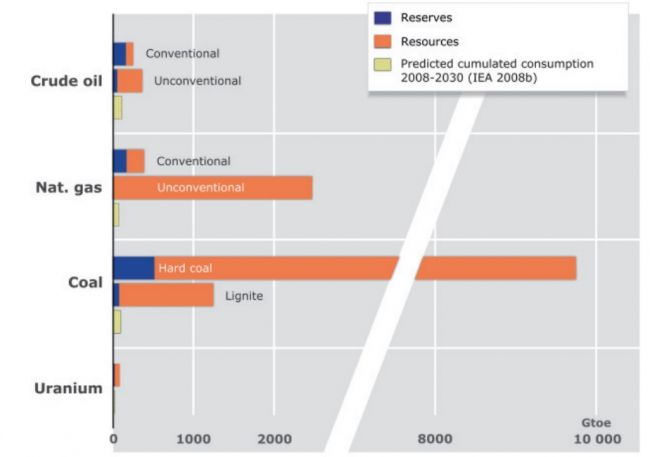
Source: https://www.bgr.bund.de/EN/Themen/Energie/Downloads/Energierohstoffe_2009_Teil1_en.pdf?__blob=publicationFile&v=2
There are 1.65 trillion barrels of proven oil reserves in the world as of 2016.
The world has proven reserves equivalent to 46.6 times its annual consumption levels. This means it has about 47 years of oil left (at current consumption levels and excluding unproven reserves).
6. What technologies are there for energy production?
7. What are energy storage technologies out there?
There are many different ways of storing energy, each with its strengths and weaknesses. The list below focuses on technologies that can currently provide large storage capacities (of at least 20 MW). It, therefore, excludes superconducting magnetic energy storage and supercapacitors (with power ratings of less than 1 MW). (*https://www.eesi.org/papers/view/energy-storage-2019)
8. What is the renewable energy intermittency issue in peak and seasonal production & consumption of energy?
Due to growing concerns about the environmental impacts of fossil fuels and the capacity and resilience of energy grids around the world, engineers and policymakers are increasingly turning their attention to energy storage solutions. Indeed, energy storage can help address the intermittency of solar and wind power; it can also, in many cases, respond rapidly to large fluctuations in demand, making the grid more responsive and reducing the need to build back-up power plants. The effectiveness of an energy storage facility is determined by how quickly it can react to changes in demand, the rate of energy lost in the storage process, its overall energy storage capacity, and how quickly it can be recharged. (*https://www.eesi.org/papers/view/energy-storage-2019)
9. What is the current carbon footprint in the energy production system and consumption?
Driven by higher energy demand in 2018, global energy-related CO2 emissions rose 1.7% to a historic high of 33.1 Gt CO2. While emissions from all fossil fuels increased, the power sector accounted for nearly two-thirds of emissions growth. Coal use in power alone surpassed 10 Gt CO2, mostly in Asia. China, India, and the United States accounted for 85% of the net increase in emissions, while emissions declined for Germany, Japan, Mexico, France and the United Kingdom. (*https://www.iea.org/reports/global-energy-co2-status-report-2019/emissions)
10. What’s the most efficient alternative resource of fossil fuels currently?
Currently, a clean energy source such as Nuclear is the major alternative to fossil fuel in the energy sector. Next in line is hydropower energy. In the coming decade, solar energy is seen as one of the biggest emerging sources of energy considering current technological developments in this segment.
11. What’s the biggest challenge of renewable energy currently?
The following challanges exists:
- Energy production efficiency for current technological solutions.
- Peal and seasonal Storage of the energy (especially wind and solar) to balance flucuations in the power generation.
- Energy transportation technologies (electricity grid) and infrastructure globally. The challange is the change from a top-down energy distribution to a bottom-up.
Political scenarios also define the future of renewable energy.
12. What's the threshold for price/cost vs. capacity for production?
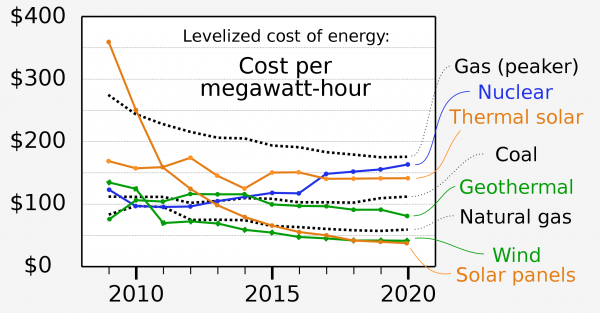
Source: https://en.wikipedia.org/wiki/Cost_of_electricity_by_source
13. How many private and public investments are made in the energy industry?
"The world committed a record $501.3 billion to decarbonization in 2020, beating the previous year by 9%. [...] Companies, governments and households invested $303.5 billion in new renewable energy capacity in 2020, up 2% on the year, helped by the biggest-ever build-out of solar projects and a $50 billion surge for offshore wind. They also spent $139 billion on electric vehicles and associated charging infrastructure, up 28% and a new record.
Other areas of energy transition investment also showed strength. Domestic installation of energy-efficient heat pumps came to $50.8 billion, up 12%, while investment in stationary energy storage technologies such as batteries was $3.6 billion,[1] level with 2019 despite falling unit prices. Global investment in carbon capture and storage (CCS) tripled to $3 billion, and that in hydrogen was $1.5 billion, down 20% but the second-highest annual number to date."
Source: https://about.bnef.com/blog/energy-transition-investment-hit-500-billion-in-2020-for-first-time/
14. What are current political scenarios driving global energy?
"The Paris Agreement [...] is an international treaty on climate change, adopted in 2015. It covers climate change mitigation, adaptation, and finance. The Agreement was negotiated by 196 parties at the 2015 United Nations Climate Change Conference near Paris, France."
Source: https://en.wikipedia.org/wiki/Paris_Agreement
The energy system has a strong link to geopolitical power, which is currently held by countries with fossil fuel advantage. Hence, the speed of adoption of green and renewable energy may become a race of power. In fact, China is committed to becoming carbon neutral by 2060.
According to Leslie Hook and Henry Sanderson, "There are two schools of thought about the energy transition. One believes it is a kind of clean energy realpolitik, marked by the desire to gain economic advantage. The actions of China, the US and Europe reflect this kind of thinking. But the other is that clean energy will involve a lot less geopolitics and might help reduce conflict — a more utopian future."
Source: https://www.ft.com/content/a37d0ddf-8fb1-4b47-9fba-7ebde29fc510
System Diagram
System Map Drafts
Systems Map Draft 1
Systems Map Draft 2
System Map Final
Driving Forces
New Driving Forces
Other Driving Forces
Fishbone Analysis
Scenario Matrix Map
Scenarios
Scenarios Overview
Scenario 1 - Black Future
(Minh Nguyen Duc)
Key Question:Will global political scenario drive renewable energy? Scenario Answer: No
Scenario Stats:
Surprising 7/10
Likely 4/10
Nobody would have thought that 2022 was the year the world political leaders decided to deprioritize the efforts for sustainability and energy transition in favor of the economic recovery after the COVID-19 pandemic, such a massive trade-off that caused the worst global crisis in energy management and how we power things in the history of mankind. The year 2021 saw the highest-ever usage of coal in energy production. Power generation from coal is set to jump by 9% in 2021 to an all-time high of 10,350 terawatt-hours, said the IEA.
Starting in early 2020, the COVID-19 pandemic has quickly become an unprecedented disruption to all aspects of lives. According to Congressional Research Service, the virus has reduced global economic growth by -3.2% and shrunk global trade by -5.3% in 2020. In 2021, thanks to the vaccination scheme and re-opening policy, the situation showed signals of recovery, with the 2021 global economic growth forecast (on November 10, 2021) to be 5.9%. However, the mutated Omicron variant of the virus, discovered in November 2021, unfortunately quickly diminished the effort, creating strong pressure for world leaders across public and private sectors to reignite the growth at all costs. As a result, from 2022, the previously committed investments to foster the mass adoption of renewable energy, whether research and development, grid infrastructure, storage innovation, and adoption, etc, started to be deprioritized for other short-term value creation investments. Long story short, the world decided to sacrifice the medium and long-term impact for short-term economic recovery. Three years later, in 2025, regardless of all the efforts made, the global economy was recovering not at the expected speed. The world leaders, consequently, were debating about the right set of action and prioritization, whether to continue the path they were following or to go back to pre-COVID commitment to foster the energy transition. Meanwhile, conventional energy companies remained wanting to make more money; hence, making tremendous lobbying efforts to postpone the passing of the laws to increase the utilization of green energy, an act that was fairly successful in making the delays. This, on the other hand, received countless criticism from environmentalists, NGOs, and activists. Around the world, many protests have been happening, aiming to raise awareness of climate change and to ask for a better commitment and investment in the energy transition.
Despite all of those, the reluctance from the governments and the public sector remained to major roadblock for the progress of energy transition. This, unfortunately, brought about the biggest energy crisis in human history, which the world was witnessing, in 2030. In the course of a decade, the percentage of renewable energy consumption in the world only increased marginally by 10% (from 19% to 29%), which means that renewable energy accounts for less than one-third of the world’s consumption today, which comes extremely short vs the ambition set before COVID times. What’s more, over the past ten years, the world has added 0.5 billion habitats, resulting in 27% increase in energy demand, which then led to more CO2 emissions. As a result, global warming is at the highest-ever alert – the average temperature of the world has gone up by 1.8 degrees Celsius, reaching its peak in history. Chemical pollution seriously jeopardizes people’s and animals’ health. The sea level has risen by 36 cm, resulting in losing half of the Netherlands, and this will continue to be the case. On this chaotic backdrop, the world is getting over-populated as we are losing more land. And the Earth will soon become a dying planet until the equilibrium is established again.
Scenario 2 - Grey Future
(Sebastian Vinkenflügel, Wei Chou Wang)
Key Questions:
Will global political scenarios drive renewable energy? Scenario Answer: Yes
Will energy storage solve the intensity issue of renewable energy? Scenario Answer: No
Scenario Stats:
Surprising 5/10
Likely 6/10
2022
Nobody would have thought in year 2022, the new renewable energy act of the politics leads to a heavy push towards renewable energies with massive subsidies. With the wide availability of funding from politics, the installation on renewable energy, such as solar and wind increased significantly. Utility companies extended their investments and used available space to install photovoltaic and wind turbines. However, due to the sharp drop in price for photovoltaic installations, the focus relied mostly on solar energy.
2025
In 2025, even though the investments in renewable energies increased significantly, seasonal, and peak storage of energies did not keep up with the technology and stay below the installed capacity of the renewable energies. The availability of energy storage has only marginally increased. The current politics are not incentivizing the use of energy storage, which leads to a low interest and limited investments in research and development in that technology, for larger corporations. Fossil fuel energy is still needed to a large extend to close the gap between the renewable energy and the demand.
2030
The global economy heats up with a total GDP of $114 trillion. Global renewable energy investment reaches $694 billion (doubled from $365 billion in 2020), the energy storage capacity has only doubled (to 34 GW), marginally compared the renewable energy installations. The price of renewable energy dropped to $95/MWh (previously $190/MWh in 2022).
Due to the lack of peak and seasonal energy storage, the fossil fuel energy industry still has to keep its entire fossil power generation capacity available, in warm and cold reserve, to close the gap between renewable energy generation and customer demand during peak demands. Even though large capacities of renewable energy have been installed, the energy price has increased to almost $1 per kWh, because the old power plants need expensive maintenance to keep running. Costs which are directly forwarded to customers. Energy intensive industries, such as steel sector, are facing challenges to maintain profitability, while the high energy price on the end customer level increased the inequality. Low-income households are facing challenges to pay their electricity bills.
For days without wind, and little sun, the fossil fuel power generation needed to cover the entire peak demand. On days when the weather suddenly changed from a cloudy, windless day, to windy, with the wind blowing away the clouds, starting to power the wind turbines and ramping-up the solar power generation, the fossil fuel power generation is not able to shut down the same speed, due to the inflexibility of old power plans. Coal fired power plants need half a day to power-up or down, too slow for only 30 minutes until the wind has started the entire renewable energy power generation capacity, in a country like Germany. This provides a significant over generation, which causes the power grids to collapse. Local power outages to end-consumer are frequent, usually weekly, with several hours without power, sometimes up to an entire day, sometimes daily. The power outages are needed from the utility industry until the grids are stabilized again, and power is again available. Private homes usually have emergency diesel generators to keep the smartphone charged and the fridge running, adding exhaust, including carbon dioxide to the atmosphere, usually without any filters.
Local initiatives and protests are on the rise, demonstrating against renewable energies and high electricity prices. There are almost 100 times as many initiatives against renewable energies as there are for, while politicians are not revising their decision for renewables, leaving a grey future uncertain, alternating between new renewable energies and traditional fossil fuel energies.
Scenario 3 - Green Future
(Abdallah Mteir, Hadeel Khawaldeh)
Key Questions:
Will global political scenarios drive renewable energy? Scenario Answer: Yes
Will energy storage solve the intensity issue of renewable energy? Scenario Answer: Yes
Will PV (solar) be deployed at end-user level? Scenario Answer: No
Scenario Stats:
Surprising 7/10
Likely 5/10
Nobody thought that in 2022 the renewable energy disruption will be swift and successful in the energy and transport sector by 2030. Oil, natural gas (methane), coal, and uranium will become obsolete for the purposes of generating significant amounts of electricity and powering the automobile. And the government started with the support of the complete transform of the energy generation system to the renewable resources. German Energiewende, as an example, currently has 45% of the energy resources from renewable sources (wind and solar), as a result, this is reducing the CO2 emissions by 40%. The transform derived people who refused to accept shortages and undesirable spillovers from extractive industries, also, environmental movements became active to support the low-carbon future. As a result, the government agreed to make a complete transform to the renewable energy. As a result, the chain will follow after that. Many Europeans will start the transform as well. We believe that 80% of the developed country will be running on 80% Renewables and 50% for the developing countries.
By 2025, successful innovation disruption in the storage of renewable energy will solve issues around energy intermittency. Traditional power stations will not be cost-effective, as cheap and clean energy is widely available. And for that, the Lithium Ion will be a perfect fit in the peak time as the prices of lithium ion batteries are decreasing 15% every year. But for the seasonal batteries (Li-Ion) are not good for long-term storing, so the Hydrogen, Liquid Metal (Ambri) & Liquid Sulfur will be suitable. The Ambri company is already having a test on Ambri batteries.
By 2027, the concept of energy architecture is changed and moved away from resource-based. Alternately, the architecture is based on an enlarged consumer role in being able to produce energy and becomes more responsive to variable patterns of supply and demand (decentralized), thus demise the traditional energy facilities.
by 2030, homes will produce more energy than it needs through its renewable generators, so it can sell back the excess energy to spaces or others that will require more energy through in-home batteries. Also, the home energy management system (or HEMS) concept will emerge and become familiar, which is defined as a piece of technology that will manage energy flow and usage within the home.
In regards to automobile fuel, energy will transform to hydrogen as it is the single most abundant substance in the universe, and bio-based fuel along with small and efficient electric energy storage.
When renewable resources are not feasible, bio-based fuel will play an important role in many industries. For example, in the transport sector the bio-based fuel for air traffic, maritime transport and heavy duty traffic on the long term. Also in the buildings sector, it will become primarily in buildings that are difficult to modernize.
Scenario 4 - Yellow Future
(Richa Kushwaha)
Key Questions:
Will global political scenarios drive renewable energy? Scenario Answer: Yes
Will energy storage solve the intensity issue of renewable energy? Scenario Answer: Yes
Will PV (solar) be deployed at end-user level? Scenario Answer: Yes
Scenario Stats:
Surprising 8/10
Likely 5/10
In 2022, global warming due to rising CO2 emissions alarmed the end-users and thus demand for clean energy sources provided a significant pull through the energy industry emphasizing the expansion of renewable energy, such as photovoltaic and wind power. Nuclear energy was seen as the future alternative to fossil fuel energy production but its popularity went down due to multiple accidents such as Fukushima & radioactive waste generation and unethical disposal of this waste.
In a similar timeline, early experiments with in-home battery technology have proven extremely successful. Households were using a mix of solar energy which is provided by solar panels on their roof and hydro energy provided by conventional grids. Battery storage technology is showing promising results, UK housing association installed solar panels and batteries in a number of their properties as a trial. Some residents were able to meet 90% of their energy needs with solar energy, and so reduce their overall electricity bill. This highlights both the environmental and financial potential of battery storage.
By year 2025, the pull of renewable energy results in the first larger installations of renewable energy installations. The power supply from renewables starts to become more vastly available and start to exceed the traditional power generations. The renewable energies started to destabilize the electricy grid, due to volatility. Furthermore, traditional power generation units still have to be kept as cold reserve to balance out the volatility of supply from the renewables.
The first breakthroughs for solid state batteries have been completed and the first companies experimented with the large-scale production.
By year 2027, the electricity grid becomes more destabilized due to the renewable energies. The end consumer is experiencing first outages in the electricity supply. However, larger outages were able to be avoided as that time. Additional renewable energy power stations are on the way to be completed during the next years. Due to the price drop PV installations on roofs become very common. First houses are being equipped with solid state batteries to balance the supply and demand and provide intermediate storage e.g. to load electrical cars. The production of solid-state batteries are now fully running. The demand is significant.
By 2030, Electricity is mostly produced on the low or medium voltage level and only shared within the community and only rarely beyond it. The batteries are balancing out the supply and demand. Storage installations of batteries are able to last for several days, in larger communities’ weeks, or even months, being able to meet supply and demand. Fossil fuel power plants are still kept available for long cloudy, days, without wind. However, the classical top-down energy supply is fully disrupted. Energy for houses becomes a very cheap resource for everybody.
Web Resources
- https://www.weforum.org/agenda/2016/11/5-predictions-for-energy-in-2030/
- https://en.wikipedia.org/wiki/World_energy_supply_and_consumption
- https://www.ft.com/content/ab8933bc-84f3-43dc-b5ef-cd259ef77a11
- https://samsetproject.wordpress.com/2015/07/27/258/
- https://assets.kpmg/content/dam/kpmg/au/pdf/2021/kpmg-30-voices-on-the-future-of-energy.pdf
- https://www2.deloitte.com/nl/nl/pages/energy-and-resources/topics/future-of-energy.html
- https://octopusgroup.com/insights/the-future-of-energy-in-2030/
- https://www.agora-energiewende.de/fileadmin/Projekte/2019/EU_Big_Picture/153_EU-Big-Pic_WEB.pdf
- https://www.statista.com/statistics/265598/consumption-of-primary-energy-worldwide/
- https://www.eesi.org/papers/view/energy-storage-2019
- https://www.iea.org/reports/global-energy-co2-status-report-2019/emissions
- https://www.energy.gov/sites/prod/files/2020/12/f81/Energy%20Storage%20Market%20Report%202020_0.pdf
- https://www.seattletimes.com/business/study-only-2-of-global-giving-goes-to-curb-climate-change/
- https://www.ft.com/content/a37d0ddf-8fb1-4b47-9fba-7ebde29fc510
